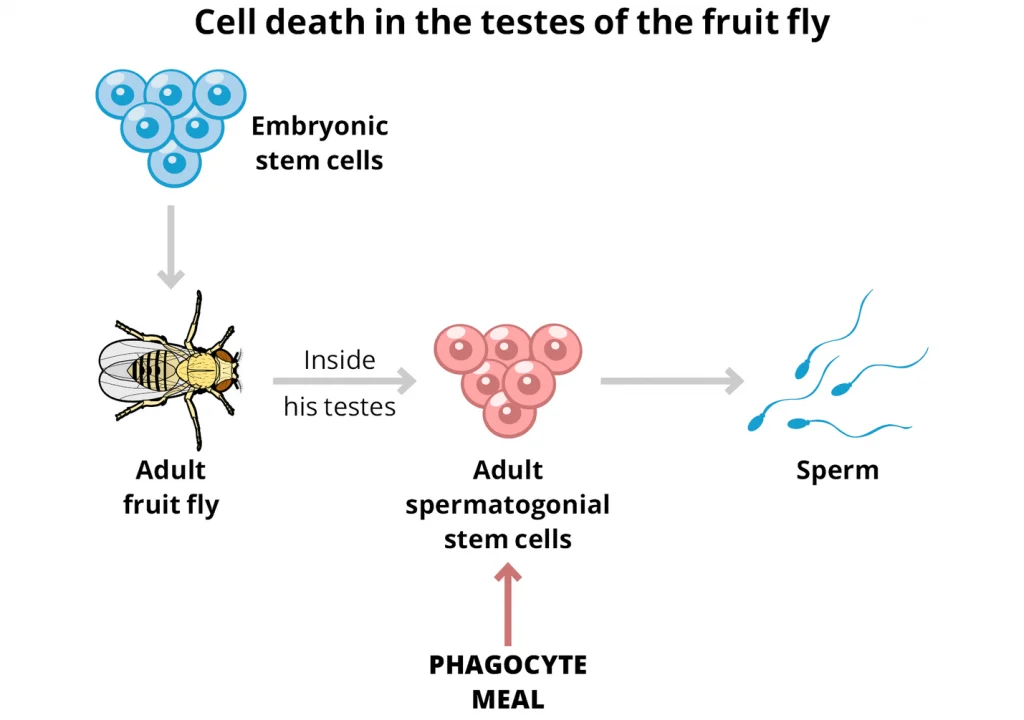New Study
Identifies Assassin Cells
Research by: Prof. Hila Toledano
A new study held at the University of Haifa has identified for the first time a process involving the “murder” of live newly-generated cells. The study, published in the prestigious journal Science Advances, found that phagocytic cells swallow and dissolve normal live cells during the process of cellular differentiation in fruit flies. “We found that phagocytes can function as ‘murderers.’ It is well-known that phagocytic cells swallow and dissolve dead cells, but we show for the first time that they also kill newly-created normal cells. Essentially we have characterized a new mechanism of cell death. The more we know the mechanisms of cell death, the better we understand how to cope with various diseases, particularly cancer”, explained Prof. Hilla Toledano, head of the Department of Human Biology at the University of Haifa, the author of the study.
Stem cells are the founders of many tissues in the human body such as skin, hair, gut and testis. These potent stem cells allow replenishment of tissues by continually providing fresh cells to replace the spent ones. In this process, each stem cell first divides into two – a stem cell that remains for future use and another cell that differentiates and replaces the lost cell within the tissue.
In the present study, Prof. Toledano in collaboration with Prof. Estee Kurant and a team of researchers from the University of Haifa, examined the sex cells of fruit flies. Fruit flies serve as a useful model in this instance since many molecular mechanisms in flies and humans are similar. Research in fruit flies is advantageous by the ability to monitor processes in live tissues and the ease of genetic manipulations, facilitating the precise identification of cellular processes. Over the years, six Nobel Prizes have been awarded to researchers who identified biological processes in fruit flies that are conserved in humans.
As mentioned, the differentiation process of sperms in male fruit flies begins with the division of a stem cell into two: a stem cell and a cell known as a progenitor, which continues the differentiation process until the formation of functional sperms. From earlier studies, the researchers already knew that one-fourth of these progenitor cells die and do not become sperms. In the current study, the researchers sought to understand what happens to these cells.
Cell death is an established and essential process in the body. Under normal conditions, cells can “commit suicide” when a severe mutation occurs or after they have completed their function. When the cells die, phagocytes arrive to “eat” them, essentially removing and dissolving their content. In specific instances, it is known that phagocytes “eat” live cells of the immune system that have fought against invaders and completed their function.
In the current study, the researchers found that the phagocytes “murder” a quarter of the progenitor cells in the testis although these cells are doing nothing “wrong” and are simply in the process of differentiation; they are still new cells and they are not abnormal in all respect.
In the first stage, the researchers prevented the eating abilities of the phagocytes and found no dead cells in the tissue. In other words, the phagocytes are responsible for the death of the progenitor cells.
In the second stage, the researchers used real-time imaging to monitor live tissue and discovered that the progenitor cells are swallowed alive by the phagocyte, and only then the death process is initiated. “We found for the first time a process entailing the ‘murder’ of completely normal cells. We still do not know why this happens. Perhaps this process aims to supply nutrients to maintain a functional population of stem cells throughout the lifetime of the organism” Prof. Toledano suggested.
In addition to the understanding of a new mechanism, this study can contribute to our abilities to develop drugs and means to control cell death, and particularly, of course, for treating cancer. “Tumors are characterized by constant growth and the disruption of the process of natural cell death. If we manage to introduce phagocytes in this process that are capable of eliminating the live cancer cells, we will be able to control the growth of the tumor. The more we learn about mechanisms of cell death, the better we can harness these processes to get rid of cancerous cells,” Prof. Toledano concluded.

